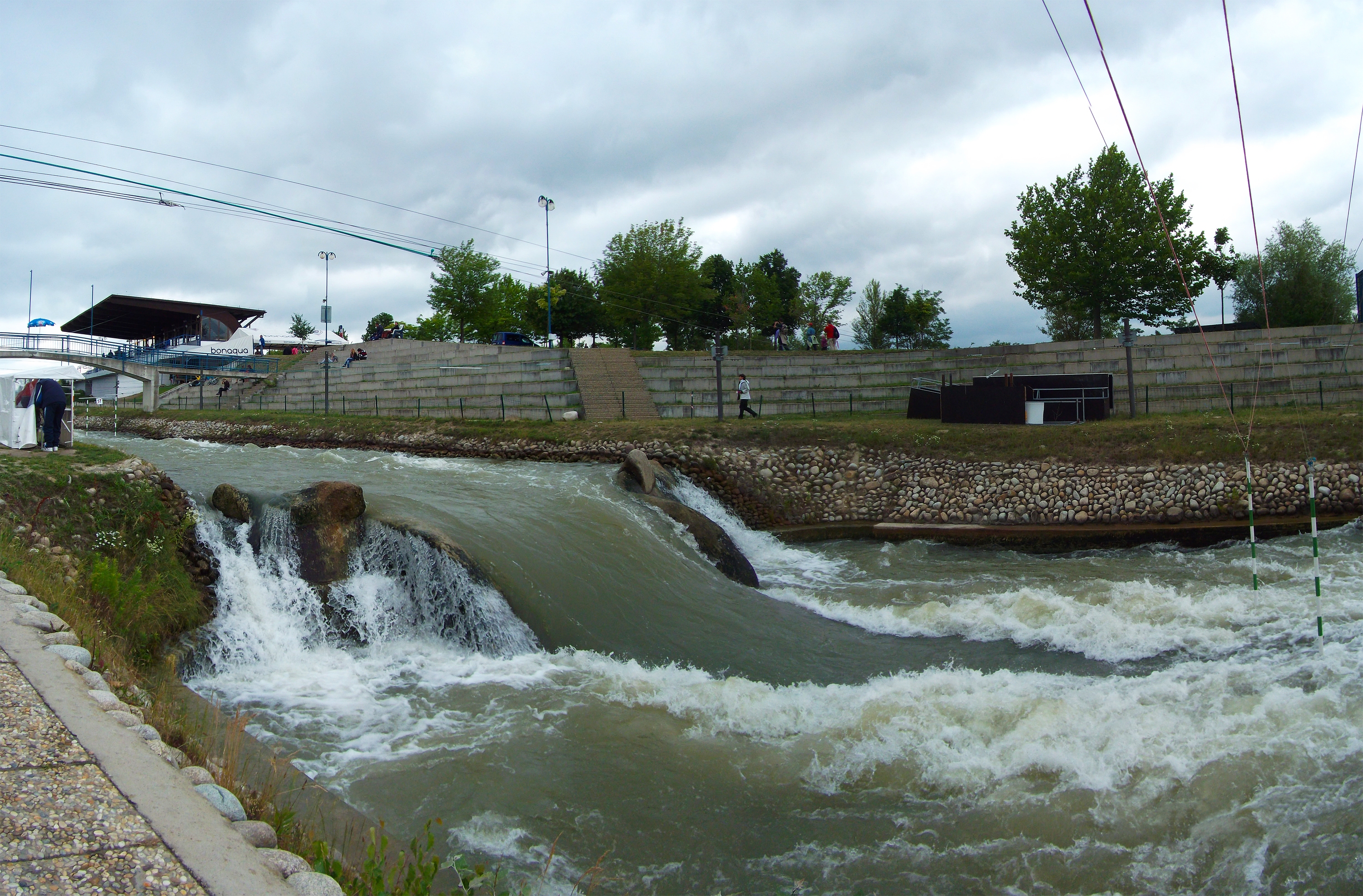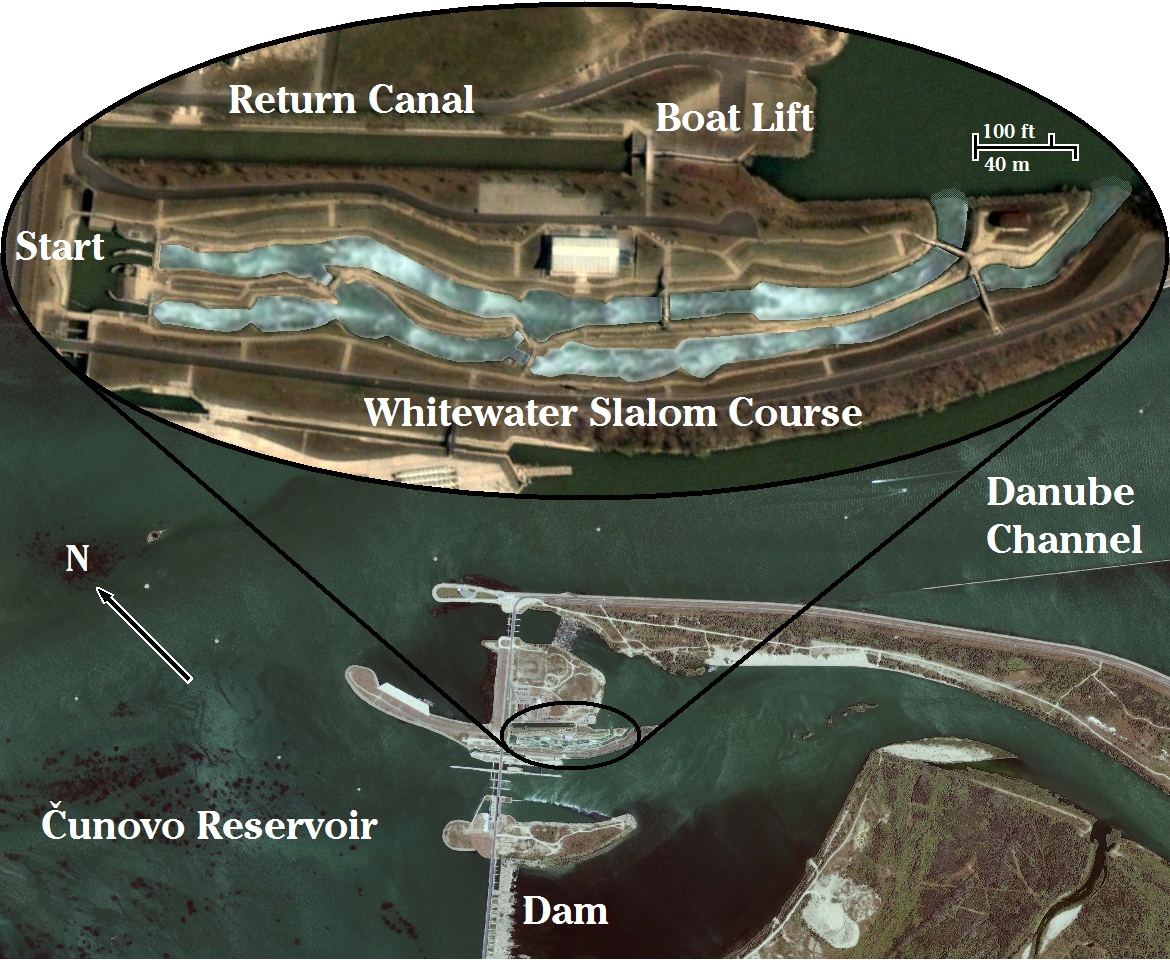ÄŚunovo Water Sports Centre on:
[Wikipedia]
[Google]
[Amazon]
The ÄŚunovo Water Sports Centre is an artificial whitewater slalom course in
 The centre has two parallel whitewater channels; the drop is the same for both channels, . The left channel is 356 meters long, with a 1.9% slope of 19 m/km (98 ft/mile) and a streamflow of 7 to 22 m3/s (247 to 777 ft3/s). The right channel is 460 meters long, with a 1.4% slope of 14 m/km (76 ft/mile) and a streamflow of 7 to 12 m3/s (247 to 424 ft3/s). When both channels are watered, the left channel streamflow is 15 m3/s (530 ft3/s) and the right is 7 m3/s (247 ft3/s).Water Sport Centre-Technical Data
The centre has two parallel whitewater channels; the drop is the same for both channels, . The left channel is 356 meters long, with a 1.9% slope of 19 m/km (98 ft/mile) and a streamflow of 7 to 22 m3/s (247 to 777 ft3/s). The right channel is 460 meters long, with a 1.4% slope of 14 m/km (76 ft/mile) and a streamflow of 7 to 12 m3/s (247 to 424 ft3/s). When both channels are watered, the left channel streamflow is 15 m3/s (530 ft3/s) and the right is 7 m3/s (247 ft3/s).Water Sport Centre-Technical Data
30 July 2007, retrieved 7 November 2012. The two channels are connected at two crossover points, making a total of five alternative routes from start to finish. From a start in the left channel, there are three ways to run the course; from a right channel start there are two. Any run which ends up in the left channel includes a sheer final drop called "Niagara." A conveyor-belt boat lift carries paddlers in their boats up to a 225-meter-long return canal on a level with the start pool. The ÄŚunovo Water Sports Centre was built in 1996 on an island near the mid-river end of the ÄŚunovo dam, a flood control feature of the ÄŚunovo to GabÄŤĂkovo dam system. The island is high enough to remain dry during floods. In March 2002 and again the same August, the whitewater course was inundated, but the buildings and most of the island remained above water. When the Water Sports Centre operates at full capacity, with the two whitewater channels carrying a combined total of 22 m3/s (777 ft3/s), it siphons off between 9% and 4.5% of the river's normal flow of 250 to 600 m3/s (8,830 to 21,200 ft3/s). Full course operation represents a 4 megawatt sacrifice of electricity production at the GabÄŤĂkovo dam 30 km farther downstream. Although the water flowing through the slalom course represents only 1.4 megawatts of power, if it stayed in the reservoir until it reached the GabÄŤĂkovo dam, with a higher vertical drop, its energy potential would be greater.When a streamflow of 1 m3/s drops 1 m in height, the power expenditure is 9.8 kilowatts. This fact makes the course more expensive to operate, in energy terms, than a similar pump-powered facility.

Official WebsitePanorama photographMid-course photoAerial photo, topAerial photo, bottom2006 video2008 video
{{DEFAULTSORT:Cunovo Water Sports Centre Artificial whitewater courses Sports venues in Slovakia Buildings and structures in Bratislava Region Sport in Bratislava Region
Slovakia
Slovakia, officially the Slovak Republic, is a landlocked country in Central Europe. It is bordered by Poland to the north, Ukraine to the east, Hungary to the south, Austria to the west, and the Czech Republic to the northwest. Slovakia's m ...
, on an island in the Danube
The Danube ( ; see also #Names and etymology, other names) is the List of rivers of Europe#Longest rivers, second-longest river in Europe, after the Volga in Russia. It flows through Central and Southeastern Europe, from the Black Forest sou ...
river, 14 km southeast of Bratislava
Bratislava (German: ''Pressburg'', Hungarian: ''Pozsony'') is the Capital city, capital and largest city of the Slovakia, Slovak Republic and the fourth largest of all List of cities and towns on the river Danube, cities on the river Danube. ...
, near the village of ÄŚunovo
ÄŚunovo (, , ) is a small part of Bratislava, Slovakia, in the southern area near the Hungary, Hungarian border. It is located close to the GabÄŤĂkovo - Nagymaros Dams.
History
ÄŚunovo was first mentioned as a village in 1232 under the name ''C ...
. It is powered by flow diversion from the ÄŚunovo dam. Since 1997, it has hosted a full schedule of local, regional, and international competitions, including multiple World Cup
A world cup is a global sporting competition in which the participant entities – usually international teams or individuals representing their countries – compete for the title of world champion. The event most associated with the name is ...
races, 2 European Championships
A European Championship is the top level international sports competition between European athletes or sports teams representing their respective countries or professional sports clubs.
In the plural, the European Championships also refers t ...
and the 2011 World Championships.
Course description
 The centre has two parallel whitewater channels; the drop is the same for both channels, . The left channel is 356 meters long, with a 1.9% slope of 19 m/km (98 ft/mile) and a streamflow of 7 to 22 m3/s (247 to 777 ft3/s). The right channel is 460 meters long, with a 1.4% slope of 14 m/km (76 ft/mile) and a streamflow of 7 to 12 m3/s (247 to 424 ft3/s). When both channels are watered, the left channel streamflow is 15 m3/s (530 ft3/s) and the right is 7 m3/s (247 ft3/s).Water Sport Centre-Technical Data
The centre has two parallel whitewater channels; the drop is the same for both channels, . The left channel is 356 meters long, with a 1.9% slope of 19 m/km (98 ft/mile) and a streamflow of 7 to 22 m3/s (247 to 777 ft3/s). The right channel is 460 meters long, with a 1.4% slope of 14 m/km (76 ft/mile) and a streamflow of 7 to 12 m3/s (247 to 424 ft3/s). When both channels are watered, the left channel streamflow is 15 m3/s (530 ft3/s) and the right is 7 m3/s (247 ft3/s).Water Sport Centre-Technical Data30 July 2007, retrieved 7 November 2012. The two channels are connected at two crossover points, making a total of five alternative routes from start to finish. From a start in the left channel, there are three ways to run the course; from a right channel start there are two. Any run which ends up in the left channel includes a sheer final drop called "Niagara." A conveyor-belt boat lift carries paddlers in their boats up to a 225-meter-long return canal on a level with the start pool. The ÄŚunovo Water Sports Centre was built in 1996 on an island near the mid-river end of the ÄŚunovo dam, a flood control feature of the ÄŚunovo to GabÄŤĂkovo dam system. The island is high enough to remain dry during floods. In March 2002 and again the same August, the whitewater course was inundated, but the buildings and most of the island remained above water. When the Water Sports Centre operates at full capacity, with the two whitewater channels carrying a combined total of 22 m3/s (777 ft3/s), it siphons off between 9% and 4.5% of the river's normal flow of 250 to 600 m3/s (8,830 to 21,200 ft3/s). Full course operation represents a 4 megawatt sacrifice of electricity production at the GabÄŤĂkovo dam 30 km farther downstream. Although the water flowing through the slalom course represents only 1.4 megawatts of power, if it stayed in the reservoir until it reached the GabÄŤĂkovo dam, with a higher vertical drop, its energy potential would be greater.When a streamflow of 1 m3/s drops 1 m in height, the power expenditure is 9.8 kilowatts. This fact makes the course more expensive to operate, in energy terms, than a similar pump-powered facility.
ÄŚunovo Dam
The "Budapest Treaty" of 1977, between Hungary and Czechoslovakia, was a plan to tame the Danube and increase its navigability with levees, dams, locks, overflow channels, and designated flood plains, and to generate hydroelectricity. The joint project was intended to cover the entire 150 km stretch of the Danube as it forms the border between Slovakia andHungary
Hungary is a landlocked country in Central Europe. Spanning much of the Pannonian Basin, Carpathian Basin, it is bordered by Slovakia to the north, Ukraine to the northeast, Romania to the east and southeast, Serbia to the south, Croatia and ...
, from the upstream, western, end at ÄŚunovo, Slovakia, to Nagymaros
Nagymaros (, ) is a town in Pest county, Hungary.
Etymology
The name comes from ''Maroš'', the Slavic form of Marianus. Nagymaros—"Greater Maros" ( Hungarian). The first written mention is ''Morus'' (1257).
Notable people
* György Szabado ...
, Hungary, in the east. Construction started when the Soviet Union broke up in 1991, but only on the Slovakian side. In 1989, Hungary had suspended its participation and in 1992 backed out of the 1977 treaty altogether. Slovakia has been in litigation with Hungary ever since.
In 1992, Slovakia completed the 30 km section from ÄŚunovo to GabÄŤĂkovo, which includes a dam at each end, each dam spanning half the river width, the two dams being connected by a 30-km long levee, all of which combine to impound the 40 km2 ÄŚunovo reservoir and force the river into a navigation channel on the left side of the riverbed. The ÄŚunovo dam, on river right at the upstream end, is a flood control feature with 27 spillways to send excess water into the bypass channel and flood plain south of the navigation channel. The GabÄŤĂkovo dam, at the downstream end, contains the main navigation locks and the hydropower plant, which began operation in 1996 and now provides electricity equal to 11% of the total Slovakian demand. Its maximum capacity is 720 megawatts at a water discharge rate of 4,000 m3/s (141,000 ft3/s).
The two dams and the levee support a two-lane road which is the first Danube river crossing below Bratislava, but vehicles must drive the length of the 30-km levee to complete the crossing. This is the road which provides access to the Water Sports Centre, mid-river at the ÄŚunovo end.
References
External links
Official Website
{{DEFAULTSORT:Cunovo Water Sports Centre Artificial whitewater courses Sports venues in Slovakia Buildings and structures in Bratislava Region Sport in Bratislava Region